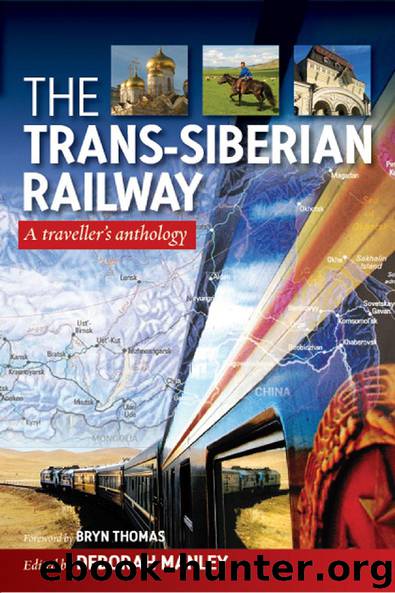The Trans-Siberian Railway by Deborah Manley

Author:Deborah Manley
Language: eng
Format: epub
Tags: Travel, Railways, Trans-Siberian, Russia, Urals, Vladivostock, Moscow, Cross-Continent
ISBN: 9781908493309
Publisher: Andrews UK Limited 2011
Published: 2011-12-07T00:00:00+00:00
***
Annette Meakin’s excitement on reaching Moscow in 1900 is a delight; John Foster Fraser saw a very different place from the city we know today.
The real Trans-Siberian journey as described by Baedeker in 1914 starts at the Yaroslavl Vokzal, the terminus of the Trans-Mongolian, Trans-Manchurian and Trans-Siberian trains. And it is from here that the travellers from the past really make the journey come to life.
The other would-be travellers changed little from those John Foster Fraser described in 1900. Leo Deutsch’s departure in 1884 was very different; and Esther Hautzig’s train (as far as she knew) did not pass through Moscow in 1941. Once on their way the travellers reported their journeys in many different ways. John Foster Fraser went slowly in 1901; Shoemaker’s gloom about eastern Russia in 1902 could be repeated today. As the train crosses the Urals, most travellers, like Shoemaker, are disappointed by the range. Sir Henry Norman, MP, thought little of the Europe-Asia boundary post, describing it as ‘a little uninspired monument, some ten feet high, in yellow freestone. It is a simple base with a stone-built, pointed column on top - the sort of thing you may find behind some trees in a park of a nobleman, raised to mark the last resting-place of his favourite fox-terrier.’ George Kennan had understood it better in 1897.
Not long after passing the boundary post, Sverdlovsk brings terrible memories, hinted at by Eric Newby, involving P. Gilliard, the Tsarevitch Alexander’s tutor, and described by Noble Frankland. The journey settles down with Peter Fleming in 1931; Malcolm Burr’s train lost its dining car in 1930; Michael Myers Shoemaker explained the strange train times which still exist today.
Life on board the train becomes all important, as John Foster Fraser in 1901 and Digby and Wright described in 1910 - broken for them only by the constant ticket inspections. Some travellers get left behind; a few explore beyond the stations. Digby and Wright found excitement in Omsk - as we soon come to expect from them. Tomsk had been bypassed by the railway and in 1900 Annette Meakin had trouble reaching it. Digby and Wright stayed out later than most travellers and so saw more of Tomsk life. Samuel Turner, like others, had trouble with the hotels, and Lesley Blanch’s dressmaker had trouble on the train. Morgan Phillips Price found Krasnoyarsk colourful in 1910, and after the River Yenisey Malcolm Burr and Annette Meakin all found pleasure in the scenery.
Download
This site does not store any files on its server. We only index and link to content provided by other sites. Please contact the content providers to delete copyright contents if any and email us, we'll remove relevant links or contents immediately.
Modern China. A Very Short Introduction by Rana Mitter(646)
The Lost Heart of Asia by Colin Thubron(628)
Steve by Steve Walker(440)
The Book of The Book by Idries Shah(418)
A History of Korea by Michael J. Seth(407)
Korea by Michael J. Seth(405)
Museum Of Innocence by Orhan Pamuk(383)
Insight Guides Pakistan (Travel Guide eBook) by Insight Guides(376)
Continuing Korean by King Ross & Ph. D. Jaehoon Yeon & Insun Lee(358)
The Temples of Kyoto by Donald Richie(356)
The Trans-Siberian Railway by Deborah Manley(330)
Delhi by R V Smith(324)
Scoop-Wallah - Life on a Delhi Daily by Justine Hardy(321)
A Travel Guide to Homer by John Freely(319)
Among the Tibetans by Isabella Bird(318)
From Sea to Sea; Letters of Travel by Rudyard Kipling(308)
Leaving India by Minal Hajratwala(305)
Persian Pictures by Gertrude Bell & Liora Lukitz(304)
Frommer's Dubai and Abu Dhabi Day by Day by Gavin Thomas(282)
